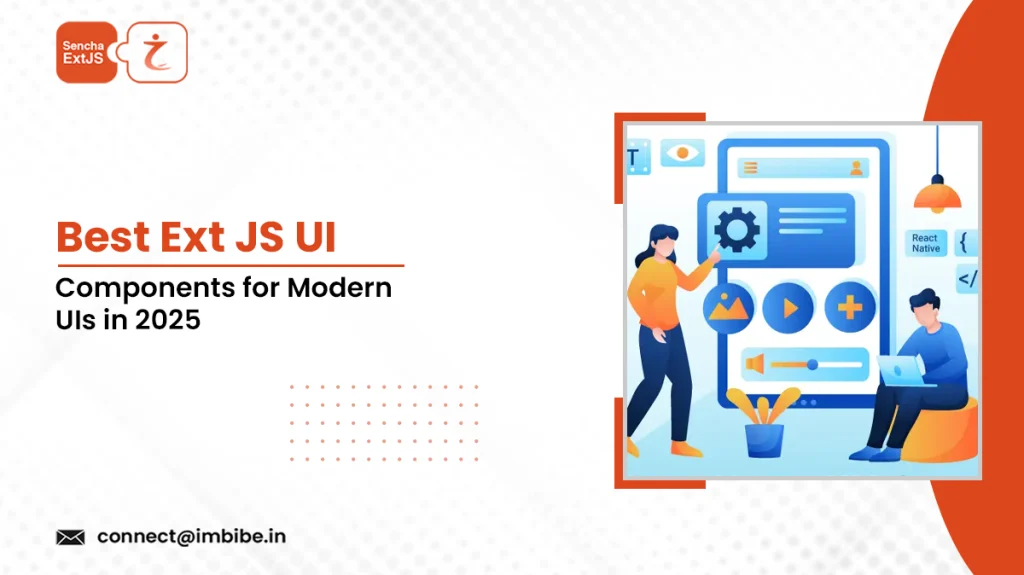In 2025, web development isn’t just about making things look good. It’s about building apps that are fast, responsive, and easy to manage. Developers need strong tools that can handle everything from layout to data visualization. That’s why Ext JS remains one of the top choices for serious projects.
It’s not just another JavaScript framework. Ext JS is made for performance. It gives you all the tools you need to create large, enterprise-grade applications. You don’t have to search for third-party plugins or combine multiple libraries. With ExtJS Pre-Built Components, you get a complete set of UI elements that work well out of the box.

Why Ext JS Still Leads in 2025
Modern developers want speed, simplicity, and control. Ext JS offers that. It gives you pre-built grids, charts, forms, calendars, buttons, menus, and a lot more. These aren’t basic widgets, they’re advanced components that can handle real-world tasks like sorting, filtering, editing, and displaying large datasets without lag.
If you’re building dashboards, internal admin panels, or client-facing portals, Ext JS helps you save time. It also ensures your app runs smoothly on all devices. From desktops to tablets and mobile phones, everything adjusts automatically. You don’t have to write separate code or rely on external responsive libraries.
Themes That Save Time and Keep Design Clean
Styling is one of the hardest parts of app development. You want your app to look modern and professional, but writing custom CSS for every screen can be frustrating. That’s where ExtJs themes make a big difference.
Instead of dealing with raw CSS files, you can change fonts, colors, spacing, and layouts. It’s a simple, visual way to style your app. Whether you want a light theme, dark mode, or something that matches your brand, the theming tools are easy to use. You can create a consistent look across the whole app without digging into stylesheets. This saves hours during development and makes updates easier in the long run.
Real Power for Data-Heavy Applications
Many modern web apps deal with massive amounts of data. Whether it’s a dashboard for stock market trends or a backend system for hospitals or logistics, you need components that can handle complexity. Ext JS offers a Grid component that’s fast, flexible, and customizable. You can sort, filter, group, paginate, and even edit data in real-time.
For more advanced needs, the Pivot Grid lets you create Excel-style views where users can drag and drop data fields. You can build real-time reports, summaries, and comparisons right inside your app. Combined with live charts, Ext JS allows you to turn raw data into smart visualizations in just a few clicks.
Built-in Support for Forms and Inputs
Collecting user input is a basic task, but doing it well is another story. Ext JS gives you a wide range of form elements like text fields, dropdowns, sliders, date pickers, and checkboxes. These come with built-in validation, bindings, and layout controls.
Instead of writing extra logic to validate forms or format user data, Ext JS handles it for you. Whether it’s a registration form, settings page, or data entry screen, you can build it quickly using Ext JS Pre-Built Components. The components behave the same across browsers and devices, which reduces bugs and makes maintenance easier.
Works Across Devices Without Extra Setup
Today’s users expect the same experience on every device, whether it’s a laptop, tablet, or phone. Ext JS offers built-in responsive design. You don’t have to write custom breakpoints or manage media queries. The layout engine automatically adjusts the size and position of components.
This is a huge time-saver when building Progressive Web Apps. Ext JS supports offline access, fast loading, and push notifications, all using the same codebase. You can even convert your app into a mobile-ready version without starting from scratch.
Speed and Performance That Scales
When apps grow, performance becomes a real challenge. Ext JS handles this with smart features like virtual scrolling, lazy loading, and data handling. It helps you load only what’s needed, when it’s needed.
That means smoother interfaces, faster page loads, and a better experience for users, even when you’re dealing with massive data sets. In fact, for enterprise-scale needs, Ext JS is often more stable and less buggy than frameworks that rely on stitching together multiple libraries.
Backed by a Strong Developer Community
A good framework needs a strong developer base, and Ext JS has it. With years of use in enterprise environments, the community is active and experienced.
Whether you’re a beginner or an experienced developer, you’ll be able to understand how the components work and how to get the most out of them. You also get access to tools like for automated testing and for visual UI building.
Used in Real Business Applications
Ext JS isn’t just popular in theory, it’s used in real business apps every day. It powers financial dashboards that need live data updates, healthcare apps with strict compliance needs, eCommerce admin tools with advanced filters, and even logistics platforms with live tracking features.
These apps rely on the stability and scalability of Ext JS. They use ExtJs themes for clean branding and rely on ExtJS UI Components to save time and ensure consistency. Whether you’re building a startup MVP or an enterprise platform, Ext JS adapts to your needs.
Final Thoughts: Why Choose Extnuke by Imbibe Tech
In 2025, choosing the right tools can decide how fast you build and how well your app performs. Ext JS continues to lead with strong, reliable components that just work. It supports modern layouts, responsive design, and full integration.
If you’re looking for custom solutions, expert help, or just want to explore what Ext JS can really do, Extnuke by Imbibe Tech is here to help. We build custom themes, offer UI support, and create modern solutions based on Ext JS for teams of all sizes.
Visit Extnuke to discover how we can help you deliver modern apps faster, with cleaner code, smoother UIs, and better performance.
